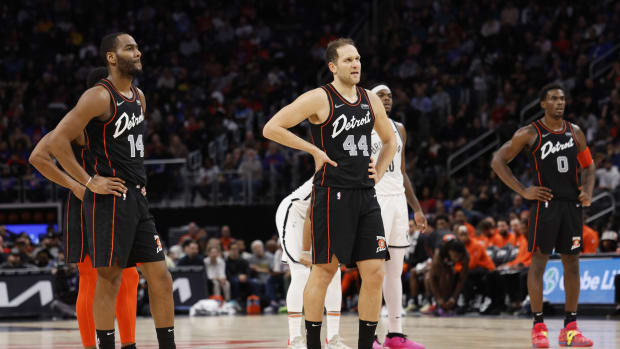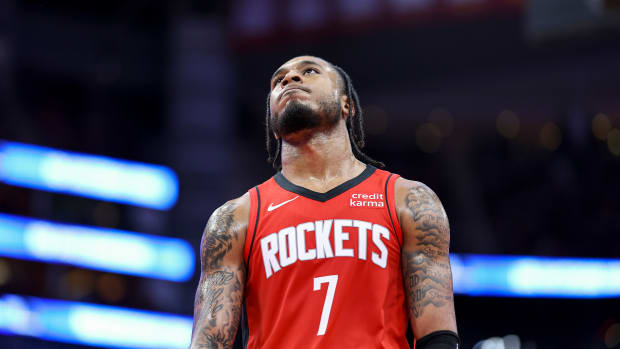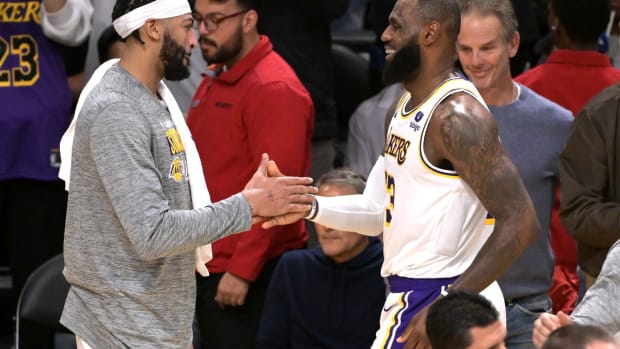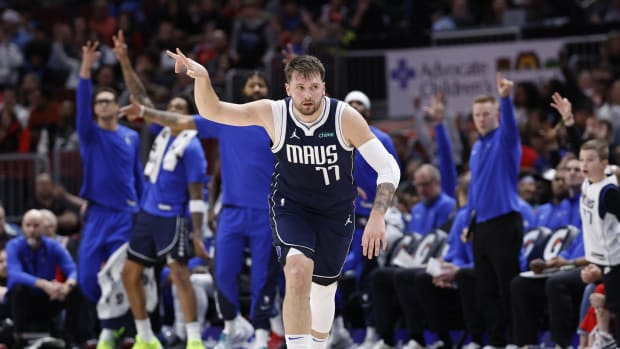What’s the Path to the Playoffs for the East’s Middle Class?
While the Western Conference is presently a mess of 14 teams battling for playoff position (sorry, Phoenix), the East standings are neatly sorted as we head into the season’s second half. The top five teams are near-locks for the postseason, with Milwaukee, Toronto, Indiana, Philadelphia and Boston set to battle for seeding down the stretch. On the flip side of the East standings, the conference’s bottom tier should see a solid tankathon over the next three months. The Cavaliers are a mess and look destined for the league’s worst record. Don’t discount the tankability in New York, Chicago or Atlanta, either. Expect plenty of minutes and shots for each team’s slate of youngsters as they tumble toward a greater share of ping-pong balls in the coming months.
FISCHER: Stretch Provision Comes with Cash and Complication
Between the contenders and the tankers, though, is a middle class of teams that have yet to be properly sorted. Six East teams are within four games of each other as we roll through January, with Nets and Wizards bookending the Nos. 6 through No. 11 seeds in the East. Each of the middle six teams could see themselves hosting a Game 3 in the Eastern Conference first round, while a trip to the top 10 of June’s draft is also firmly on the table. Don’t expect any tanking efforts from these squads (although Washington could lean into the lottery if the losses pile up). There are too many impatient owners and establishing cultures, and in some cases, perhaps the revenue from a pair of playoff games is worth a quick first-round exit.
There’s little use predicting who will be the three teams to round out the East field, with little separation between the competing squads in both record and net rating. Instead, we at The Crossover decided to assess the playoff formulas for each team, and what they’ll rely on to reach the postseason come April.
Nets: Let the Threes Fly
Brooklyn’s recent resurgence from the Billy King-induced rubble has been admirable, led by one of the league’s best coaching efforts with Kenny Atkinson at the helm. The Nets don’t have an All-Star on the roster—and are without Caris LeVert following his November injury—but Brooklyn enters Friday night sixth in the East at 21–22. The three-point line is a central reason why. Atkinson’s crew flings triples with delight, ranking fourth in the NBA in made threes and seventh in three-point percentage.
The modern shot profile has done wonders for Brooklyn, with a heavy emphasis on threes, layups and free throws. You’re more likely to see D'Angelo Russell and Spencer Dinwiddie fire from 28 feet than 18 feet. The Nets have seven players with at least 100 three-point attempts on the season, trailing only Boston for the league’s top spot. After a trio of depressing seasons at the Barclays Center, playoff hoops could return to Brooklyn on the backs of a three-point revolution.
Heat: Don’t Bury Bam
Is there a more jumbled rotation in the league than the one in South Beach? The Heat play 11 players over 20 minutes per game. Josh Richardson leads the team in field goal attempts despite ranking 37th in the NBA in the category. Miami has plenty of mouths to feed, tasking Erik Spoelstra with the nightly duty of unlocking the winning combination.
NADKARNI: NBA Free Agency Is Not Always Your Friend
The full cast of characters poses a significant juggling act in the backcourt with Dion Waiters’s return to the lineup, but perhaps the diciest dance comes in the frontcourt. Spoelstra must find minutes for Hassan Whiteside, Bam Adebayo and Kelly Olynyk. Whiteside’s contract and ego necessitate a large share of minutes—as does his impressive rebound rate, in fairness—yet the reliance on Whiteside often comes at the expense of perhaps Miami’s best lineup option. The Olynyk-Adebayo combo ranks second on the Heat in net rating, with Miami outscoring opponents by 11.5 points per 100 possessions when the pair share the floor. Olynyk is a malleable offensive big with the necessary stretch for an often-clogged attack, while Adebayo is an energizer bunny of the highest order.
Whiteside’s shot blocking is a necessary deterrent at times, but too often his offensive demands outweigh his physical tools. Adebayo is much of the production without all of the headache. He should earn a greater share of minutes moving forward.
Hornets: Follow Kemba’s Lead
Money and loyalty could very well drive Kemba Walker to a long-term deal with Charlotte this summer, but don’t expect the Hornets' supporting cast to play a large role in his decision to stay in the Queen City. Kemba’s castmates are a rough group, filled with contract albatrosses and unproven youngsters. Is Jeremy Lamb the second-best Hornet? Who can Charlotte reasonably rely on outside of Walker? The Rich Cho era left slim pickings in Charlotte.
The Hornets' lack of secondary scoring punch provides even more reason to ride their dynamic point guard over the next three months. Walker is averaging career-highs in points per game and usage rate, in line for a third straight All-Star appearance. His nuclear week in November (including 60-point and 43-point efforts on back-to-back nights) was the high-point of Charlotte’s season, even though the Hornets lost to Philadelphia when Walker erupted for a 60 piece. The Hornets sit at eighth in the East entering Friday night, in line for their first playoff appearance since 2015-16. Letting Walker cook like he’s back at UConn is their best hope at another postseason berth.
Pistons: Let Point Blake Shine
Speaking of subpar supporting casts, have you watched Detroit lately? The Pistons are 4–19 since Dec. 3, losing six of their last seven contests. The good vibes of the Pistons’ hot start have faded, and what looked to be a solid playoff team has fallen out of the top eight. Blake Griffin has cooled following his three-point explosion to start the year, and the rest of Detroit’s roster hasn’t picked up the slack. The Pistons path to the playoffs is murky.
Despite Griffin’s slowed shooting, he’ll need to embrace his role as a high-usage creator for Detroit to sniff the playoffs. The former Clippers' playmaking and vision has always been an asset, able to generate open looks as a point-forward. Griffin feasted early in the year on pull-up threes and self-generated post-ups. His work pushing into the lane created three-point opportunities for Reggie Bullock and Ish Smith, much more effective than the collection of clanked jumpers generated by Reggie Jackson. Griffin should lead the way as Detroit’s offensive initiator, a near-necessity considering the Pistons’ collection of uninspiring second options.
Magic: Ride the Length
In a league filled with quality point guard play, Orlando’s rotation consists of D.J. Augustin and Jerian Grant. No disrespect to the former Longhorn, but Augustin is more of a serviceable bench presence than reliable starter at this point in his career. The Magic could benefit from a more creative lineup.
Head coach Steve Clifford would be smart to embrace rotations that veer toward positionless basketball. At their best, the Magic are a swarming collection of arms and length, headlined by recent lottery selections Jonathan Isaac and Mo Bamba. Six of Orlando’s best-nine lineups by net rating (min. 300 minutes) feature Isaac, led by the trio of Isaac, Aaron Gordon and Nikola Vucevic. Perhaps Clifford should go wild and add Bamba to the frontcourt triumvirate, trusting Vucevic to provide the necessary stretch. The Magic rank No. 28 in offensive rating, anyway. They should trust their defensive identity as they seeks their first playoff appearance since 2011-12.
Wizards: Embrace Sixth Man Otto Porter
With John Wall out for the season, the Wizards will need a mammoth effort from Bradley Beal and Otto Porter to sneak into the postseason. And each will need to ride relatively solo to maximize Washington’s limited scoring punch. Beal is the headliner, of course, a coveted trade asset and burgeoning leading man. He’s averaging career-highs in points, shot attempts and usage rate. He initiates a significant share of the Wizards’ attack, a leap from his previous role as a floor-spacer and secondary ball handler. Will it be enough to keep Washington afloat?
MANNIX: Can the Raptors Convince Kawhi to Stay in Toronto?
Not without Otto Porter. Washington’s $107 million man displayed impressive potential as a three-and-D weapon since entering the league in 2013, but regressed through the season’s first half. He’s making 37.9% of threes after crossing 43% in each of the last two seasons. His scoring is down as is offensive rating. With John Wall’s contract already a potential albatross, Porter’s slide created a frightening future in the nation’s capital.
A change in role has paid dividends over the last week. Porter moved to the bench in Washington’s victory over Philadelphia on Wednesday night and poured in 23 points, free to work as more than a three-point outlet when paired with Washington’s bench unit. Porter will still close games with Beal, but he should be free to run the bench mob with Wall on the sidelines.




































